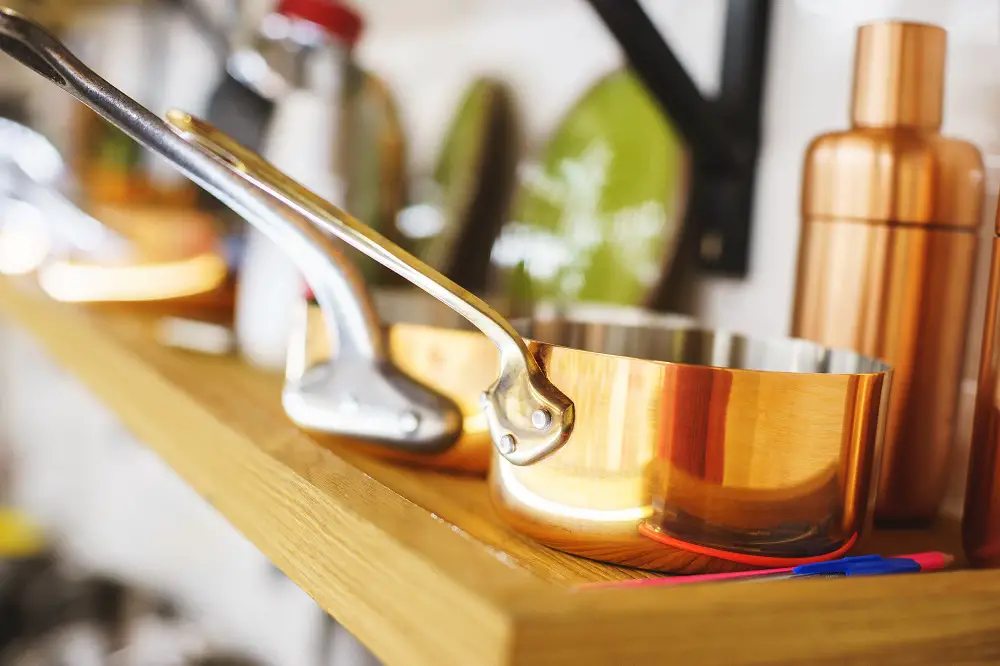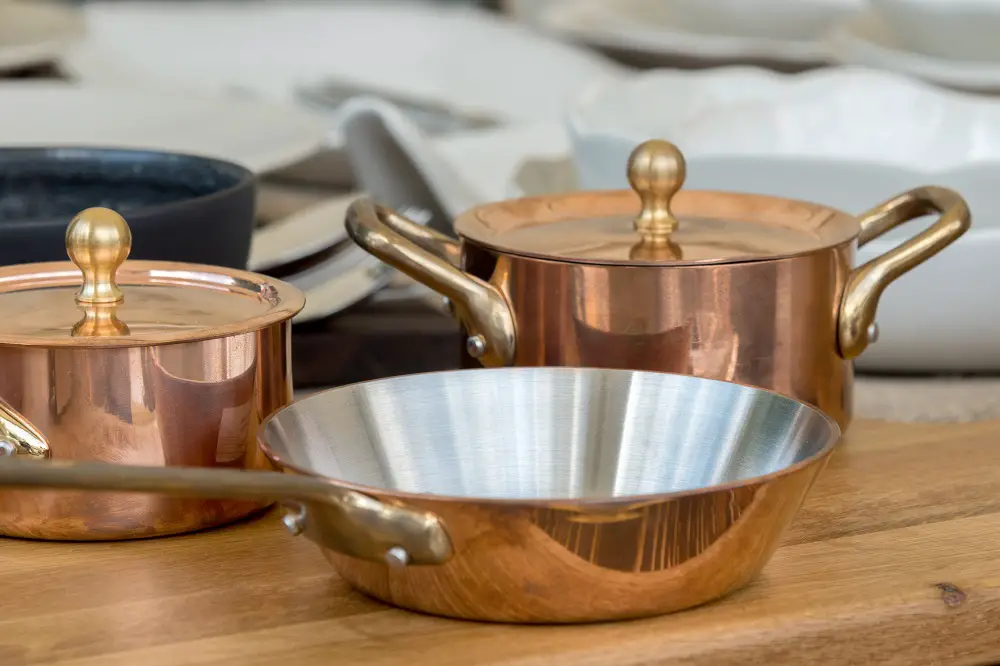
For many professional cooks, copper cookware is the go-to choice. But is it really superior to other types of cookware materials? Good copper cookware heats food evenly and efficiently, so you can cook those delicate dishes that are temperature sensitive.
But there are many people who wonder if copper cookware is safe to cook with. And in most cases, yes, but there are some exceptions in which cooking with straight copper can have a negative impact on the quality and taste of your food.
Table of Contents
Is Copper Safe to Cook With?
Yes. Most types of copper cookware are safe to cook with when they’re used correctly. Tin and stainless steel lining are used to prevent the copper from coming into contact with your food.
Since copper is a toxic material when ingested it’s important that you pay attention to the quality of the lining material and cease using the pot or pan, should you notice that the lining has become scratched or is wearing down.
Advantages
Just like all cookware materials, there are pros and cons to using copper pots and pans. The biggest advantage copper offers are the high thermal conductivity, which enables the cooking surface to heat up evenly and quickly in addition to responding quickly to any type of temperature change.
The cookware’s high thermal conductivity allows pans to rapidly establish an equal temperature throughout the entirety of the cooking surface. This works wonders when it comes to eliminating hotspots that can cause food to stick or burn.
Disadvantages
As I mentioned earlier, many people who have no experience with copper cookware are concerned that it’s unsafe. The biggest disadvantage that comes with cooking with untreated copper pots and pans is that the metal can leach into food.
Because copper is a type of toxic metal it should never be ingested. In order to solve this issue, copper cookware is now lined with stainless steel or tin.
Tin Lining

Tin can produce an incredibly smooth nonstick surface and it’s a type of inert metal that conducts heat almost as well as copper. Additionally, this type of metal is not as likely to leach into your food as it cooks. It’s also very easy to clean and prevents exposing you to copper.
The big drawback of tin lining is that it’s much softer compared to other types of metal that are used to line pots and pans. Because it’s soft, over time, it can wear out and it’s more liable to dents and scratches compared to tougher metals such as stainless steel.
Because this metal is soft any type of tin lined pot or pan must be used carefully in order to avoid scratching the lining and exposing the copper that lies underneath. The use of metal implements should be avoided when preparing food in a tin lined pan.
Tin also has a melting point of 450 degrees so cooks must also take extreme caution and avoid using this type of cookware when a recipe calls for a cooking temperature near 400 degrees.
Stainless Steel Lining
Stainless steel is usually the go-to option for lining material in modern pieces of copper cookware. While stainless steel doesn’t conduct heat nearly as well as tin or copper, it can be applied to the interior in a very thin layer which can help improve heat conductivity. Stainless steel will not easily dent, or scratch and it’s not known to oxidize, rust, or tarnish.
Some types of copper cookware that are made with stainless steel can also be placed in the dishwasher, however, you will need to check with the manufacturer prior to doing so. In most cases, it’s best to wash copper cookware by hand in order to avoid tarnishing the finish.
One of the biggest drawbacks that comes with cookware that’s lined with stainless steel is that the surface is very rough compared to other materials. This means that the food you’re cooking will be more likely to stick to the cooking surface if you don’t use some type of cooking oil.
If you’re not careful, you can end up with a pot or pan with burnt on or stuck-on food. Fortunately, there are some tips and tricks you can try that can make cleaning this type of cookware a breeze. To learn more, click here to read my article on how to clean copper cookware.
Low Gauge Copper Cookware
For some, another major disadvantage of copper cookware is the price. Copper is more costly than other types of cookware materials. With copper, the thicker the gauge the higher the price. A higher gauge also equals a faster heat-up time and better heat distribution.
There are some lower-gauge copper cookware sets that are still a good option especially for the family on a tight budget. However, these pots and pans don’t have the same reputation for even and fast heating or precise temperature control.
Final Thoughts
So, is copper cookware safe to cook with? In most cases, copper cookware is perfectly safe to use as long as the lining it’s not worn down or scratched. These days, pots and pans that are made out of copper are more commonly lined with stainless steel than tin.
However, if you do have copper cookware with tin lining then you’ll need to be prepared to have the pots and pans relined once you notice that the lining has started to wear down or have become scratched or pitted. You won’t have to worry about relining your cookware if the lining is made out of stainless steel.
However, in terms of copper poisoning, studies have shown that even if you were to cook with a straight copper pot or pan or cookware with a damaged tin lining, you would not be able to ingest enough copper to cause illness. Instead, the copper may just negatively impact the color and taste of your food. So, while using a copper pot or pan is not much of a health risk, you should still avoid using copper cookware with damaged lining.
Originally posted 2020-05-17 11:01:20.


![7 Best Island Punch Pucker Substitutes [ALMOST Identical]](https://wowcookery.com/wp-content/uploads/2022/05/island-punch-pucker-90x75.jpg)
![10 BEST Luxardo Bitter Bianco Substitutes [ALMOST Identical]](https://wowcookery.com/wp-content/uploads/2022/05/luxardo-90x75.jpg)






